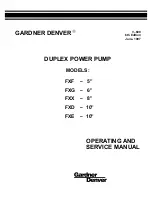
GB
GB
- 15 -
4. Technical data
Mains connection: ................. 220 - 240 V ~ 50 Hz
Power consumption: ................................... 680 W
Pumping rate: ...........................................3800 l/h
Delivery head max. ...................................... 36 m
Delivery pressure max. ...........0.36 MPa (3.6 bar)
Suction height max. ....................................... 8 m
Pressure
connection: ... approx. 33.3 mm (R1 male thread)
Suction
connection: .... approx. 33.3 mm (R1 male thread)
Water temperature max. ............................... 35°C
Tank capacity: .................................................18 l
Cut-in pressure approx.: ..........0.15 MPa (1.5 bar)
Cut-out pressure approx.: ............0.3 MPa (3 bar)
Sound power level ........................... 81.52 dB (A)
Uncertainty ..............................................4.99 dB
Protection type: .............................................IPX4
5. Before starting the equipment
Before you connect the equipment to the mains
supply make sure that the data on the rating plate
are identical to the mains data.
As a basic principle, we recommend the use of
a preliminary filter and a suction set with suction
hose, intake cage and non-return valve, in order
to prevent long priming periods and unnecessary
damage to the pump as a result of stones and
solid foreign bodies.
5.1 Connecting the intake line
•
Fasten the suction hose (at least approx. 19
mm (3/4“) plastic hose with spiral reinforce-
ment) to the suction connection approx. 33
mm (R1 male thread) of the equipment either
directly or via a threaded nipple.
•
The suction hose used should be equipped
with an intake valve. If the intake valve cannot
be used, a non-return valve should be ins-
talled in the intake line.
•
Position the intake line so that it rises from
the water withdrawal point to the equipment.
Avoid positioning the intake line higher than
the pump, as this would delay the escape of
air bubbles from the intake line and impede
the priming process.
•
Install the intake and discharge lines in such
a way that they do not exert any mechanical
pressure on the equipment.
•
The intake valve should be low enough in the
water to ensure that if the water level falls, the
unit will not run dry.
•
A leaking intake line will draw in air and there-
fore not draw in any water.
•
Prevent the intake of foreign bodies (sand,
etc.). If necessary, install a coarse filter for
this purpose.
5.2 Connecting the discharge line
•
The discharge line (min. 19 mm (3/4“)) must be
connected to the 33.3 mm (R1 male thread)
discharge line connector of the equipment
either directly or with the aid of a threaded
nipple.
•
With the right couplings it is also possible, of
course, to use a 13 mm (1/2“) delivery hose.
The smaller delivery hose results in a lower
delivery rate.
•
During the priming operation, fully open any
shut-off mechanisms (spray nozzles, valves,
etc.) in the pressure line so that the air can
escape without obstruction.
5.3 Electrical connections
•
Connect the appliance to a 220 - 240 V ~ 50
Hz socket-outlet with earthing contact. Mini-
mum fuse 10 ampere.
•
A built-in thermostat protects the motor from
overloading and blocking. The pump is swit-
ched off automatically by the thermostat if
overheating occurs and is switched on again
automatically after cooling.
6. Operation
•
Install the equipment on a solid and level
surface.
•
Fill the pump housing with water via the water
filler screw (3). Filling the intake line will acce-
lerate the priming process.
•
All the shut-off devices in the discharge line
(spray nozzle, valves etc.) must be fully ope-
ned during intake in order to permit all air to
escape from the intake line.
•
Connect the mains cable.
•
Switch on the equipment with the power
switch – priming can take up to 5 minutes at
maximum suction height.
•
The equipment will shut down when the cut-
out pressure of 3 bar is reached.
•
After a loss of pressure due to water con-
available).
•
Check to see if all items are supplied.
•
Inspect the equipment and accessories for
transport damage.
•
If possible, please keep the packaging until
the end of the guarantee period.
Danger!
The equipment and packaging material are
not toys. Do not let children play with plastic
bags, foils or small parts. There is a danger of
swallowing or suffocating!
•
Domestic waterworks
•
Original operating instructions
•
Safety instructions
3. Proper use
Applications
•
Irrigation and watering of green areas, vege-
table beds and gardens.
•
Operation of lawn sprinklers.
•
For drawing water from ponds, streams, rain-
water butts, rainwater cisterns and springs
•
For supplying service water
Transport media:
•
For the pumping of clear water (fresh water),
rainwater or light suds/service water.
•
The maximum temperature of the fluid must
not 35°C if the equipment is opera-
ted permanently.
•
Do not use the equipment to pump inflamma-
ble, gassing or explosive fluids.
•
The pumping of aggressive liquids (acids, al-
kalis, silo seepage etc.) as well as liquids with
abrasive substances (sand) must likewise be
avoided.
•
This equipment is not designed to convey
drinking water.
The equipment is to be used only for its prescri-
bed purpose. Any other use is deemed to be a
case of misuse. The user / operator and not the
manufacturer will be liable for any damage or inju-
ries of any kind caused as a result of this.
Please note that our equipment has not been de-
signed for use in commercial, trade or industrial
applications. Our warranty will be voided if the
machine is used in commercial, trade or industrial
businesses or for equivalent purposes.
Anl_NHW-E_68_SPK7_1.indb 15
Anl_NHW-E_68_SPK7_1.indb 15
23.03.2021 13:25:24
23.03.2021 13:25:24
















































